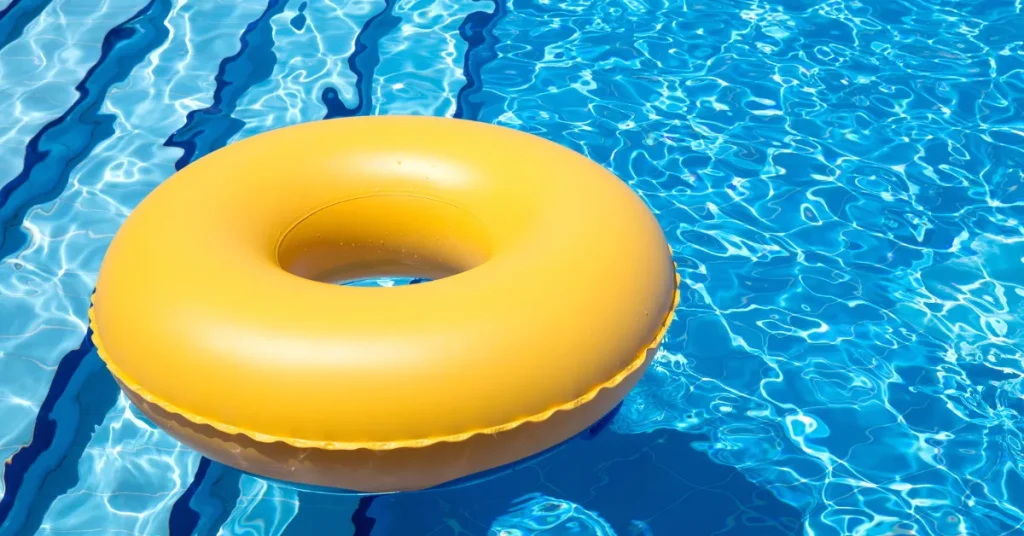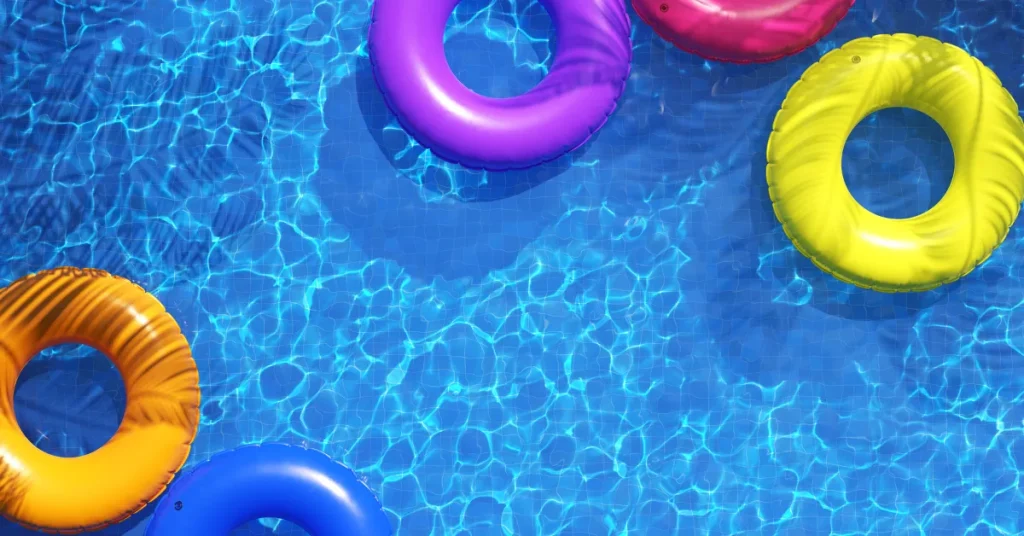Pool depths can vary widely, typically ranging from 3 feet to 12 feet. Residential pools often average around 4.5 to 5.5 feet.
Pools come in an array of shapes, sizes, and designed depths to cater to different needs and activities. A standard pool depth is suitable for activities such as swimming laps and playing pool games, maintaining a balanced environment for swimmers of various skill levels.
Dive pools, however, have deeper sections reaching 8 feet or more to ensure safety for divers. Kiddie pools are shallower, mostly less than 3 feet, to accommodate young children.
Choosing the depth of a pool requires consideration of the intended use, safety measures, and personal preferences.
Professional pool builders can offer guidance based on industry standards and homeowner expectations to optimize the pool’s design for enjoyment and function.

Diving Into Pool Depths
Choosing the right pool depth brings fun and safety together. Begin your aquatic adventure by understanding how deep a pool can be. Remember, pool depths vary for many reasons. Let’s dive in and explore the different designs and depth ranges!
Variations In Pool Design
Pools come in various shapes and sizes, each with its unique depth. The design affects depth. This means your pool’s purpose dictates its depth. Let’s look at some common variations:
- Family Pools often feature shallow ends for kids.
- Lap Pools may have consistent depths for serious swimmers.
- Diving Pools need a deep end to safely dive.
- Infinity Pools blend design with depth for a visual treat.
Typical Depth Ranges For Different Pool Types
Each pool type has a depth range. A safe and enjoyable experience depends on this. Here’s a quick guide:
| Pool Type | Shallow End | Deep End |
| Play Pools | 3ft | 5ft |
| Lap Pools | 4ft | 4ft |
| Diving Pools | 4ft | 8ft+ |
| Competition Pools | 4ft | 6ft |
These ranges are typical but can change. Your pool’s intended use and users determine the final depth.
Standards For Competitive Swimming Pools

How deep is a pool? That question has varied answers, especially in the world of competitive swimming. Competitive swimming pools must meet certain standards for depth, length, and other features.
These guidelines ensure the safety and performance of swimmers during events. Let’s dive into the specifics of what makes a pool competition-ready.
Fina Regulations For Pool Depth
FINA, or the International Swimming Federation, sets strict standards for pool depth. These are:
- Minimum Depth: 2 meters, or about 6.5 feet, for Olympic events and World Championships.
- For all other events: 1.35 meters, or around 4.5 feet, at the starting end.
FINA’s regulations ensure swimmers have enough depth to perform without risk of injury. Pools not meeting these requirements cannot host international competitions.
Impact Of Depth On Swimmer Performance
Depth can greatly affect a swimmer’s speed and safety. Deeper water reduces waves and back-splash. This means a smoother and faster swim for competitors. Shallow pools can slow swimmers down and increase the risk of injury.
That’s why elite competitions take place in pools that meet the minimum depth requirements. Deeper pools provide a consistent experience for athletes, allowing them to perform at their best.
Understanding Recreational Pool Safety
Swimming pools bring joy and relaxation. They need the right safety measures. This ensures fun times stay safe. Ranging from shallow kids’ areas to deep sections for diving, pools can be a risk without precautions.
Safety Guidelines For Backyard Pools
- Install barriers – A fence at least 4 feet tall with self-closing, self-latching gates.
- Keep rescue equipment – A life ring or reaching pole should be near the water.
- Supervise children – Never leave kids unattended, not even for a moment.
- Learn life-saving skills – Knowing CPR can be crucial in emergencies.
- Pool covers – Use them to prevent access when the pool is not in use.
- Regular maintenance – Keep water clean and check safety equipment.
Depth Markers And Their Importance
Depth markers show the pool’s depth. They guide swimmers to safe areas. They prevent diving in shallow water. This is how they help:
| Marker Location | Depth Indication | Significance |
| Pool edge | Numbers and feet | Informs before entry |
| Pool interior | Numbers and feet | Visible during swimming |
| Transition areas | Color change | Marks shallow/deep divide |
Ensure markers are clear and legible. Check them regularly. Replace them if faded or damaged. Enjoy swimming safely!
Specialized Pools And Their Unique Depths
Welcome to the fascinating world of Specialized Pools and Their Unique Depths. These pools aren’t your typical backyard variety, each one designed with a specific purpose in mind.
The depths you’ll find in these pools vary greatly to accommodate different activities ranging from professional diving to therapeutic healing.
Let’s dive deeper into the intricate design of diving pools and the specific depth requirements for therapy and rehabilitation pools.
Design Of Diving Pools
Diving pools are marvels of engineering, tailored for athletes to practice and compete. Consider these key points:
- Depth: At least 4.5 meters, ensuring diver safety.
- Platform Height: From 1 to 10 meters for multiple dive heights.
- Water Temperature: Regulated for optimal diver comfort.
The Fédération Internationale de Natation (FINA) sets strict guidelines for diving pools to promote safety and fairness in competitive diving. These pools are not only deep but include specific features like air-cushion systems to soften water surface tension.
Therapy And Rehabilitation Pool Requirements
Pools designed for therapy and rehabilitation serve a crucial role in health and wellness. Unique depth considerations include:
| Type of Therapy | Depth Range |
| Aqua Aerobics | 1.2 to 1.5 meters |
| Physical Therapy | 1.2 to 2 meters |
| Hydrotherapy | 1.0 to 1.5 meters |
These pools have adjustable floors and water temperatures for patient needs. Depth promotes buoyancy, enhances movements and reduces joint stress. Aquatic therapy pools are versatile and cater to various patient requirements.
Maintenance And Construction Considerations

Exploring the maintenance and construction aspects of a swimming pool is critical before diving into the pool ownership journey. The depth of a pool not only influences the overall design but also the ongoing care and construction hurdles.
Let’s delve into how the depth impacts maintenance routines and what construction challenges may surface with deeper pools.
Influence Of Depth On Pool Maintenance
A pool’s depth can greatly affect maintenance efforts. Shallower pools and deeper pools behave differently, and understanding this can help ensure a crystal clear swimming experience. Deeper pools require:
- More water: This means more chemicals and more cost.
- Improved circulation: Deep sections need effective water movement to avoid algae.
- Regular cleaning: Debris tends to settle at the bottom of deep pools.
Maintenance tasks such as vacuuming and brushing can be more challenging as the depth increases. Pools with varying depths also require multi-speed pumps to ensure efficient cleaning across all areas.
Construction Challenges For Deeper Pools
Constructing a deeper pool poses unique challenges for builders. A few of these include:
| Challenge | Explanation |
| Structural Integrity | Pools with greater depth need robust walls and floors to withstand pressure. |
| Excavation Effort | Deeper digs mean more labor and potential complications with ground conditions. |
| Permitting Process | Deep pools often require additional permits and inspections due to safety concerns. |
The design stage must account for these factors, including the placement of steel reinforcements and the use of high-quality concrete. Taking these considerations into account ensures a safe and lasting pool structure.
Making A Splash: Depth’s Role In Pool Enjoyment
The depth of a pool deeply impacts fun and function. Whether it’s for family playtime or athletic training, the right depth makes all the difference. Let’s dive into how depth influences your swimming experience and pool upkeep!
Depth Preferences For Various Pool Activities
- Wading: 1-2 feet for toddlers
- Playing: 3-4 feet for most family games
- Lap Swimming: At least 4-5 feet for adults
- Diving: Minimum 8 feet to ensure safety
- Water Aerobics: 3-5 feet for a comfortable workout
| Activity | Minimum Depth | Optimal Depth |
| Wading | 1 foot | 2 feet |
| Playing | 3 feet | 4 feet |
| Lap Swimming | 4 feet | 5+ feet |
| Diving | 8 feet | 10+ feet |
How Depth Affects Heating And Water Usage
A pool’s depth affects water and heat needs. Shallow pools heat up and cool down faster than deeper ones. They use less water too, but may need more frequent cleaning. Here’s a quick look:
- Shallower Pools: Easier to heat, less water
- Deeper Pools: Retain more heat, use more water
- Water Volume: Influences chemical needs and operating costs
- Heating Speed: Shallow parts reach ideal temperature quicker.
- Temperature Maintenance: More water in deep pools means stable temperatures.
- Overall Costs: Deeper pools increase water, heating, and maintenance fees.
FAQs About How Deep Is A Pool
What Is The Standard Depth Of A Pool?
The standard depth for residential swimming pools varies between 3 feet (0. 91 meters) for shallow ends and up to 8 feet (2. 44 meters) for deep ends. However, pools designed for diving may be deeper to ensure safety.
How Deep Are Olympic Swimming Pools?
Olympic swimming pools must have a depth of at least 2 meters (approximately 6. 5 feet). This depth facilitates optimal performance and safety for competitive swimmers and is a regulation of FINA standards for international competitions.
Can A Pool Be Too Deep For A Backyard?
Yes, a pool can be too deep for a backyard. Excessive depth increases construction and maintenance costs, and may be unsafe without proper precautions. Most backyard pools are best suited with depths up to 8 feet to balance enjoyment and safety.
What Is The Minimum Depth For Diving Pools?
For safety, diving pools require a minimum depth of 9 feet (2. 74 meters), as recommended by the American Red Cross. Pools with diving boards especially need to comply with this to prevent injuries.
Conclusion
Diving into the depths of pool knowledge is key for safety and enjoyment. Every pool varies, from shallow play areas to deep lap lanes.
It’s essential to know your pool’s depth before taking the plunge. Remember, whether for leisure or training, understanding pool depth enhances your experience.
Dive in responsibly!
Resources:
1. https://www.access-board.gov/ada/guides/chapter-10-swimming-pools-wading-pools-and-spas/
